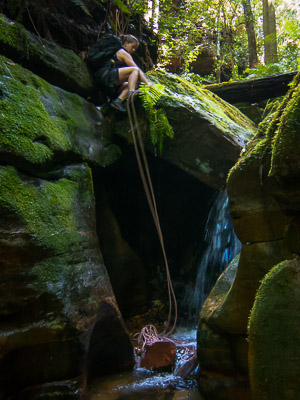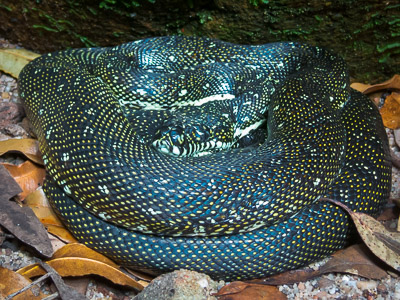On a world scale, Blue Mountains canyons are technically fairly easy.
They are most similar to the sandstone slot canyons of Utah, but with few of the difficulties of the harder canyons there. There are no keeper potholes, normally plenty of simple options for natural anchors (typically trees and chockstones), and the water is warm - relatively speaking! The abseils are typically short - it's unusual to get drops higher than 30m, and mostly they're around the 5-10m mark. On the American Canyoneering Academy (ACA) rating system, most Blue Mountains canyons would rate around a 3B.
Compared to many of the canyons of Europe and New Zealand, water flows are much lower, with no current in the pools. Hydraulics aren't an issue at normal water levels. Floating disconnects are the exception, not the rule, and water temperatures are pretty warm. On the French scale, most Blue Mountains canyons would rate around v2a2, topping out at v3a3.
The main exception to the above are the big canyons of Kanangra. They are more open gorges with large waterfalls, often 50m in height. Water flows in these canyons can be an issue after heavy rain, as they tend to hold water for days or even weeks. Best to avoid these ones if there's been a fair bit of recent rain. Under normal (dry) conditions, they are still technically not that hard on a world scale (v4a3, but only due to the size of the drops).
You can see a comparison of the grades of common Blue Mountains canyons vs international grading systems.
Nevertheless, there are a few areas where overseas visitors should take extra care:
- Navigation - the Blue Mountains is an uplifted plateau, and many of the ridgetops are only vaguely defined. The vegetation can be fairly thick, and visibility through the trees is often low. Additionally, most tracks are not marked, and even where there is a track, it may not be easy to follow. All of this means that navigation can be quite tricky. For all trips, carry a map and compass and know how to use them. You may also want to consider a GPS - and if you do, make sure you understand Australian datums and map grids.
- Scrub - Blue Mountains bush is often thick. And prickly. Wearing long pants and long sleeves is an option, but it's pretty hot in summer, and not much fun. The more popular canyons will have a track of sorts, less well-known ones you'll be doing some bush-bashing. Get used to it!
- Abseil starts - waterfalls in the Blue Mountains canyons frequently have an undercut lip, or otherwise are often caused by a boulder block-up, with a chockstone on top. The rock is plenty slippery, and the anchor is probably another chockstone, or tree, at ground level. All up, this tends to lead to tricky, overhung starts, which take some practice to deal with.

Another tricky overhung abseil start!
In addition to the above, even "easy" canyon trips like the Wollangambe River or Rocky Creek Canyon have an exit walk of at least an hour, and some 300m+ (1000ft) of climbing!
Overall the Blue Mountains is a good spot for overseas visitors as it doesn't pose many technical difficulties. However, you may still want to try and hook up with local canyoners both for the social aspect, and because they might know the routes in and out!
Time
Canyoning season is traditionally from early October to late April. The colder, wetter canyons are mostly done during the summer season of December to February. Water temperature in early December can still be a bit chilly, but with a good wetsuit is fine. The best time to visit is December to early March, as the widest range of canyons can be visited.
Gear
Wetsuits
For most people, a 3mm steamer is sufficient for canyons needing wetsuits. The water is warmest in late Feb, and many people get by with a 3mm spring suit. Sandstone canyons are moderately abrasive, and wearing a pair of shorts over your wetsuit will reduce wear.
Anchors
Bolting is not permitted in national parks, so only a small number of canyons have permanent bolt anchors. In well-known canyons, all drops will likely be rigged with tape (webbing) slings, and in some cases a maillon (maillon rapide, rapid link, quick link), ring or D-shackle. Carry a few spare slings just in case, and if you are expecting to use a 'biner block or knot block, then you should carry spare maillons.
Gear availability
Australia is a small market, and generally somewhat expensive from an international point of view. Ideally you should bring all gear you are expecting to need from home.
Any gear relating to climbing - carabiners, certain belay devices/descenders, harnesses, helmets, static rope - along with items like dry bags, can normally be found from outdoor stores in the major cities (ie Sydney) but will not be readily available outside the cities. Specialist canyoning gear is particularly hard to find.
The Blue Mountains town of Katoomba is the exception - you will find climbing gear here, and a reasonable selection of specialist canyoning gear. See the Nearby Towns page for more info on gear availablity in Katoomba.
Animals

One of Australia's non-venomous snakes, a beautiful Diamond Python
Australia has a reputation around the world for being populated by dangerous critters. In reality, the danger is overstated, particularly as applied to canyoning.
Snakes and spiders do live in the Australian bush. While there are dangerous spiders, you are very unlikely to see them while canyoning. I have not seen one in over 15 years of canyoning. No-one has died from a spider bite for over 30 years, since antivenoms became readily available. Snakes are sometimes seen, but Australian snakes, while often venomous, are also very timid. Mostly you will not see them at all, as they will hear you coming and hide. Even if you do see one, they will generally slither away. Basically if you let them be, and don't corner them, they will run rather than attack.